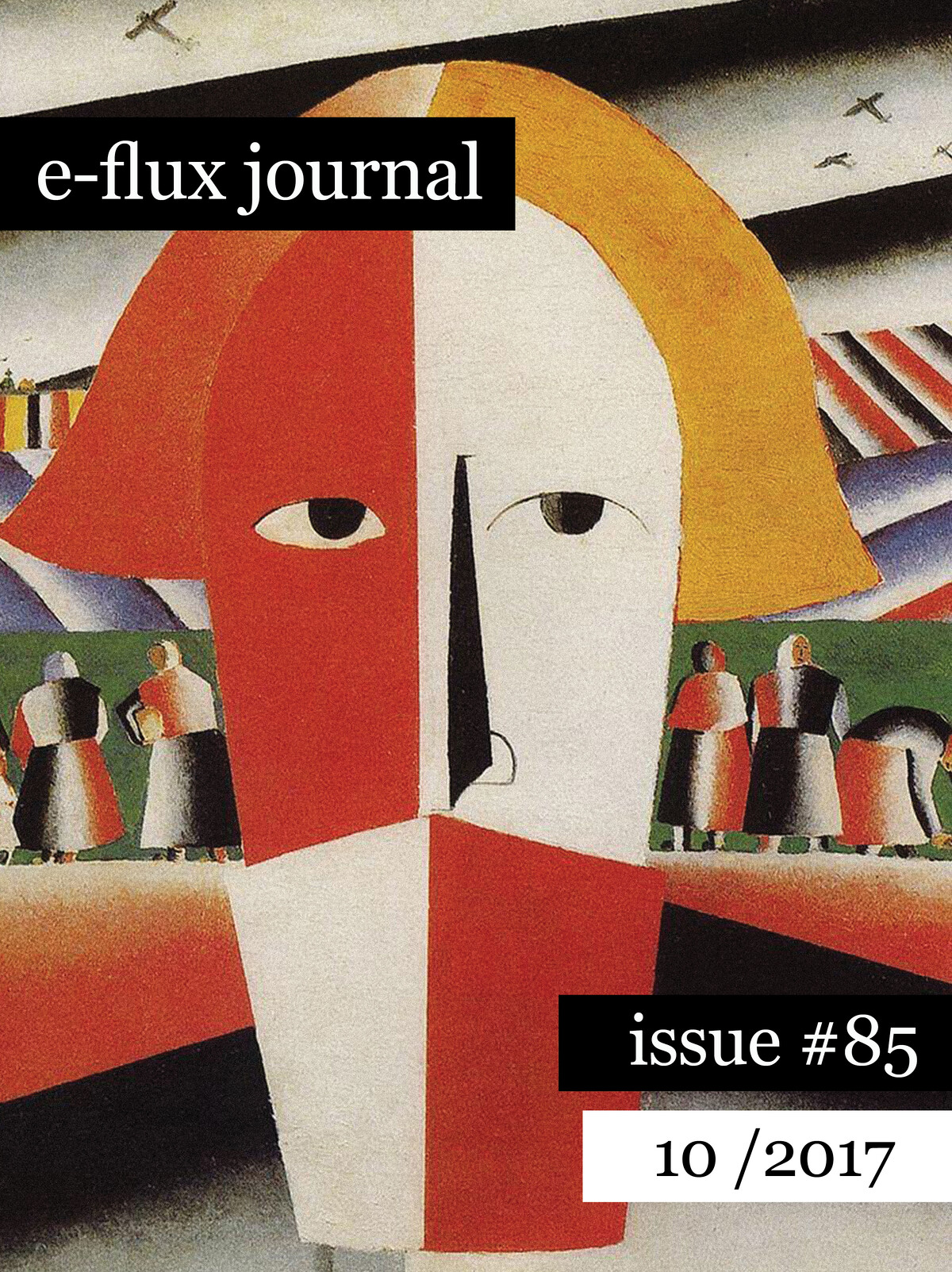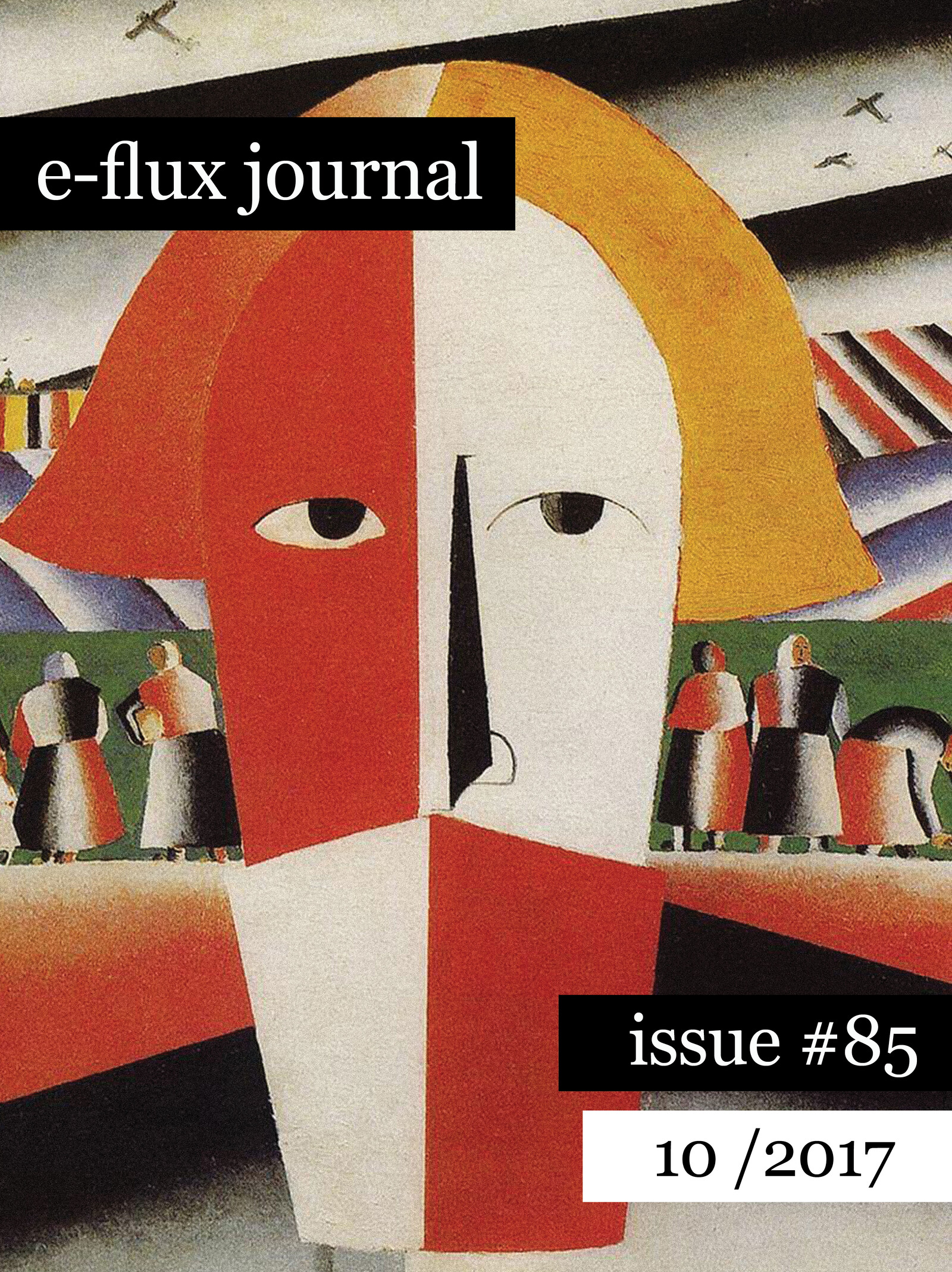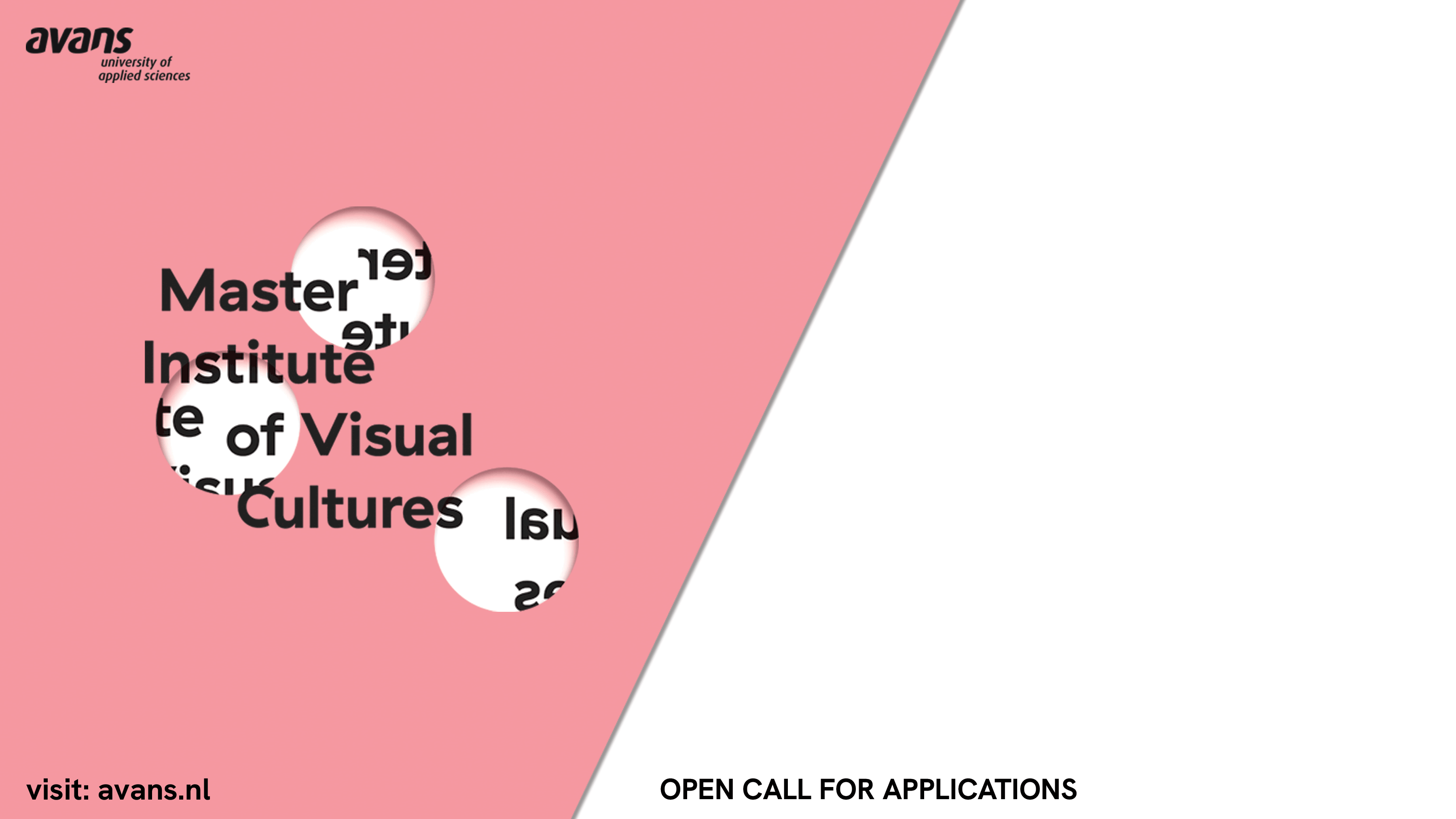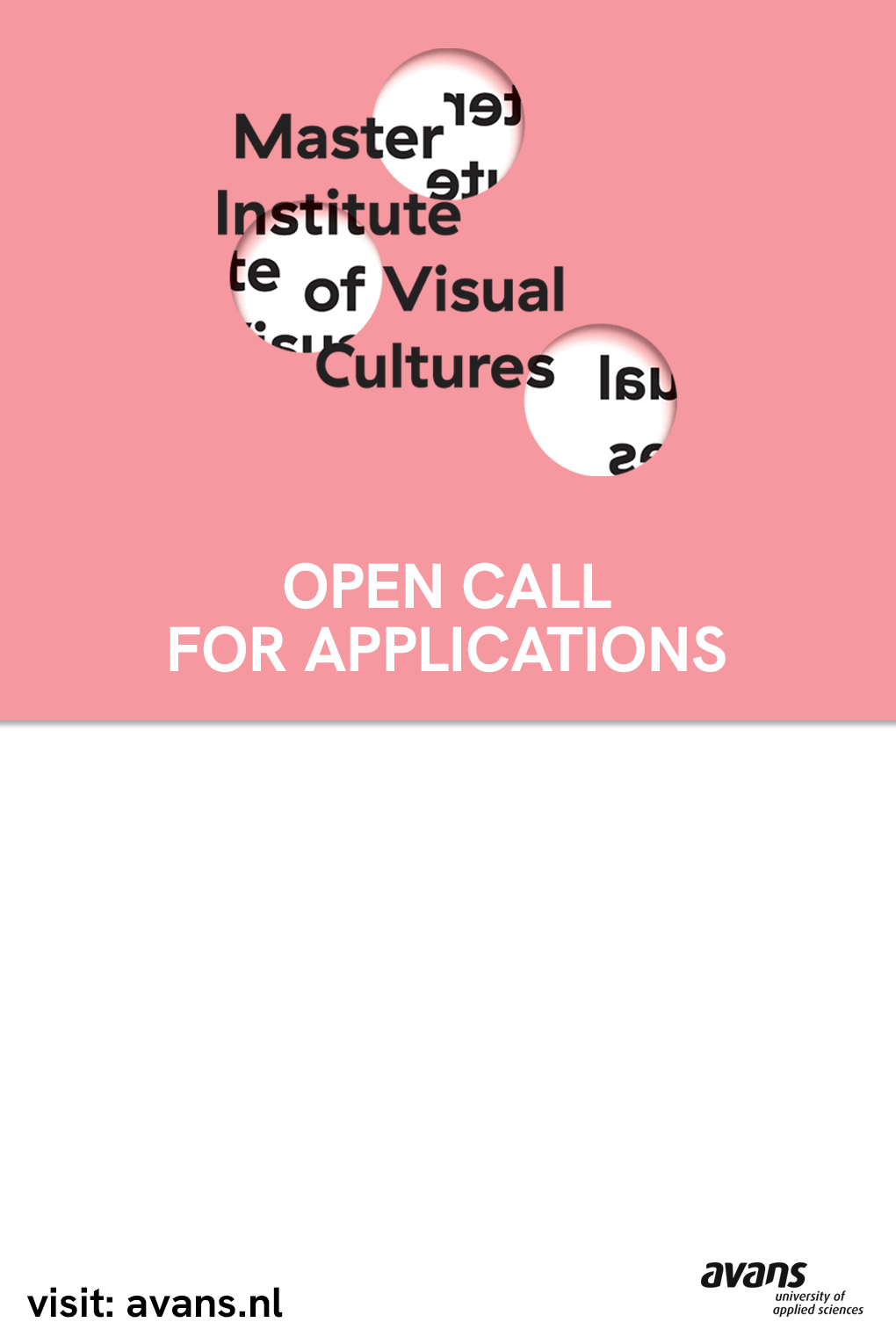with Jonathan Beller, Luciana Parisi, Brian Holmes, Aleksandra Shatskikh, Noemi Smolik, Timothy Morton, Nataša Petrešin-Bachelez, Lorenza Pignatti, and McKenzie Wark
The modern arrives when the boundaries dividing old and new become sites of struggle in the way that the divide between the sacred and the profane was previously. These distinctions—old/new, sacred/profane—are strategic: they refer to one embedded position in the life-world relative to another. In the October 2017 issue of e-flux journal, Noemi Smolik shows how, within Russia, the deployment of modernizing iconoclasm against the belief systems of Russia’s rural poor confounded distinctions between old and new, sacred and profane, even before the October Revolution and the Russian avant-garde. Aleksandra Shatskikh diagnoses a contemporary symptom of this misrecognition in the attribution to Malevich of a racialized joke scribbled by a vandal under his Black Square after it had been painted.
In retrospect, Promethean modernism was drawn and quartered between two conflicting concepts of time—time as teleology, and time as cycle. The teleological concept of time is implied in the “modern” itself, as the condition of possibility for drawing the distinction between old and new. Teleology says that the future will be new, that it will be more than the past. Under teleology, the future is a hyperobject, more than the sum of its parts, and Timothy Morton argues in this issue that it should be possible to imagine the future “subscending” the past—as being something less than what it contains. This is essential if we are going to approach the problem of climate change as a problem, rather than as a fate decided in advance. Brian Holmes revisits the theoretical and physical architecture of metropolitan modernism to consider how planetary material in the Anthropocene may finally provide for a full aesthetic reception of László Moholy-Nagy. Meanwhile, Nataša Petrešin-Bachelez points out that slowing down our institutions to a more deliberate speed is one way to avoid the dangers of linear time without presuming to transcend them.
However, Ezra Pound’s modernist axiom to “make it new” was impatient and voracious, and demanded also that we feed on the inherited concept of time—the teleological one—which the moderns rightly understood as the doddering Abrahamic eschatology dressed up in secular, dialectical dross. This need for a second, non-teleological concept of time explains modernity’s fascination with Nietzsche’s concept of the eternal return, which presents time as a cycle rather than as a linear progression from one place to someplace else. Hence the oedipal contradiction of modernity’s paternity by teleological time: it assures itself of novelty by rejecting its identification with old teleology in favor of a “new” concept of cyclical time. But any concept of the new is precisely what cyclical time rules out in advance. We are still living—and dying—in the aftermath of this contradiction. Lorenza Pignatti remembers the work of Erkki Kuriennemi, which combined a faith in the accumulation of technology with a conviction that this technology would eventually transcend the death-life continuum.
Revolution, too, is stranded between time-as-progress and time-as-cycle. Was Stalin a new and singular kind of criminal? Or just another absolute monarch, a pseudo-secular tsar empowered to act against the peasants and his political enemies, real and imagined, on an industrial scale? Luciana Parisi examines the way in which contemporary forces of representation continue to intensify our despotic traditions. One way of making progress while rejecting the colonial machine might be to increase our operating knowledge of the cycles that surround us. Jonathan Beller argues for a left reconsideration of the emancipatory potential of crypto-currency in particular and the monetary cycle more generally. Finally, McKenzie Wark tries to sell his ass to Jerry Saltz, and in the process formulates a theory of the contemporary collecting of digital objects. It may not be the end of history, but there are worse places to be than at the start of a new cycle.
—Editors
In this issue:
Jonathan Beller—The Fourth Determination
As financial media, crypto-currencies may be seen as an extremely narrow medium of expression since rather than broad-spectrum cultural relations (as with Facebook) participants engage primarily in financial speculation, and only secondarily in the qualitative offerings of a rather limited number of projects involving notions of decentralization, AI, various investing formats, data storage, and the like. On the other hand, crypto, with its publications, slack channels, meet-ups, start-up spaces, etc., could be seen as abstracting and harnessing with participants the general form of social media. It therefore represents a pared-down and more crystalline platform template for potentially all activities that transpire on social media, but with an important twist: equity for media participants. Thus, in the most generous reading, crypto-currencies function as a medium that cooperatizes social relations by giving users a share of the value of the platform they collectively create, rather than extracting their subjective energies as quantum units of value that then belong to third-party shareholders. Participant ownership of tokens is not only a right to money, a quantity of value; it is equity in the platform—direct ownership of a share of the social product.
Luciana Parisi—Reprogramming Decisionism
Computational indifference to binary problem-solving coincides with a new imperative: technological decisionism, which values making a clear decision quickly more than it does making the correct one. For decisionism, what is most decisive is what is most correct. When Mussolini gives a speech in parliament, in 1925, taking full responsibility for the murderous chaos his regime has created, and challenging his opponents to remove him anyway, he is practicing decisionism at the expense of binary logic, which would dictate that if Mussolini is responsible, then he should resign. Instead, the dictator declares that he is responsible and that he will stay. Today it is our machines who make these speeches for us.
Brian Holmes—Driving the Golden Spike
Can a waste product marketed as a valuable fuel be treated proactively as both a clear and present danger and as a public monument? Such an approach is suggested by current philosophy and cultural critique. The materialist turn toward the “agency of things,” “vibrant matter,” and “speculative realism” is driven by a need to come to grips with the suicidal overproduction that structures contemporary society. The handful of petcoke that you can pick up along the side of the river becomes the withdrawn index or impossible clue to the vast interlocking system of energy production and its consequences, on the scale of the planet earth and in the dimension of geological time.
Aleksandra Shatskikh—Inscribed Vandalism: The Black Square at One Hundred
Concerning the orgiastic frenzy that took place on the hundredth anniversary of The Black Square after the discovery of the sensational inscription, I wish to affirm with absolute conviction that Kazimir Malevich had nothing at all to do with it—the Russian avant-garde artist’s most important picture was vandalized by some “jolly and quick-witted” individual, who left a graffito on it. There have always been, always are, and always will be people who wish to debunk, unmask, and “smack down” The Black Square. Some vulgar humorist managed to leave his mark and perpetrate an outrage against the abhorrent “anti-picture.”
Noemi Smolik—The Russian Avant-Garde: A Projection Screen for Modern Utopian Thinking?
One of the key works of the Russian movement of the early twentieth century is the picture of a black square on a white background by Kazimir Malevich. It was first shown in 1915 during the “Last Futurist Exhibition of Paintings 0,10,” in what was then Petrograd, hung across the corner of one of the exhibition’s rooms. This was how peasants hung the icons in their houses. As well as the black square—listed in the catalogue simply as Square—Malevich also showed his picture of a red square entitled Painterly Realism of a Peasant Woman in Two Dimensions. What is astonishing here, however, is that Malevich relates these nonfigurative pictures, now considered to be among the high points of secular modernism, to the premodern icon and to Russian peasants living in the Orthodox tradition. How is this contradiction to be understood?
Timothy Morton—Subscendence
Subscendence affects things like nation-states, as huge and powerful as they appear. Subscendence is why you need a passport. It’s not to guarantee your identity, but to guarantee and prop up the identity of the state. Islamophobia sees Muslim terrorists as inevitably part of some larger, shadowy organization, while in the United States, white terrorists are always described as “lone wolves.” No matter how many of them shoot people in churches and outside abortion clinics and blow up government buildings, having trained in the Christian equivalent of an al-Qaeda training camp; no matter how many wolves there are, they are always seen as lone wolves, not as members of a pack. The concept that wholes are greater than the sum of their parts comes in ideologically handy because then Islamophobia can claim that Islamic terrorists are part of some emergent, shadowy whole, while white terrorists are individuals without a whole in sight.
Nataša Petrešin-Bachelez—For Slow Institutions
This is an invitation for curators operating in distinct geographies but within an intertwined geopolitical reality to slow down their ways of working and being, to imagine new ecologies of care as a continuous practice of support, and to listen with attention to feelings that arise from encounters with objects and subjects. This is a call to radically open up our institutional borders and show how these work—or don’t—in order to render our organizations palpable, audible, sentient, soft, porous, and above all, decolonial and anti-patriarchal.
Lorenza Pignatti—Experiments in Eternity: Erkki Kuriennemi
Kurenniemi was looking for a new sensorium through technological instruments and fleshy excitements such as alcohol, drugs, sex, and combinations thereof. In his life, any boundary between science, music, physics, pornography, and technology was porous. Dimi-S (aka Sexophone or Love Machine, 1972) is a device that generates sounds through the skin contact of four performers who hold electrodes that generates bio-feedback. Each Sexophone session is unique, as the sound is generated by the electric conductivity of the players’ epidermises. The players are asked to follow some instructions to activate the machine, as in Fluxus or algorithmic art. Sexophone is an ironic forerunner of cybersex.
McKenzie Wark—My Collectible Ass
I later ran into Jerry Saltz and Roberta Smith at a showing of work by Alix Pearlstein and he remembered me from the Seghal. I tried to persuade Smith and Saltz that all of Tino’s interpreters had the Seghal signature tattooed on our asses and offered to show it to them, but they did not take me up on it. I mention this because it is not just the information about the artwork circulating in the world that makes it collectible. It is also the noise. As with any other financial instrument in a portfolio, the artwork in a collection gains and loses value at the volatile edge between information and noise.
The print edition of e-flux journal can be found at:
Amsterdam: De Appel arts centre / Rijksakademie van beeldende kunsten Andratx: CCA Andratx Antwerp: M HKA Museum van Hedendaagse Kunst / Kunsthal Extra City Århus: Kunsthal Aarhus Athens: OMMU / State of Concept Auckland: split/fountain Austin: Arthouse at the Jones Center Baden-Baden: Staatliche Kunsthalle Baden-Baden Banff: Walter Phillips Gallery, The Banff Centre Barcelona: Arts Santa Mònica / MACBA Basel: Kunsthalle Basel / Museum für Gegenwartskunst Basel Beijing and Guangzhou: Vitamin Creative Space Beirut: 98weeks Belgrade: Cultural Center of Belgrade Bergen: Bergen Kunsthall / Rakett Berlin: b_books / Berliner Künstlerprogramm – DAAD / Bücherbogen am Savignyplatz GmbH / Books People Places / do you read me? / Haus der Kulturen der Welt / Motto / Neuer Berliner Kunstverein (n.b.k.) / Pro qm Belfast: Platform Arts Bern: Kunsthalle Bern / Lehrerzimmer Bialystok: Arsenal Gallery Bielefeld: Bielefelder Kunstverein Biella: UNIDEE - University of Ideas, Cittadellarte - Fondazione Pistoletto Onlus Birmingham: Eastside Projects / Ikon Gallery Bologna: MAMbo – Museo d’Arte Moderna di Bologna Bregenz: Kunsthaus Bregenz Bristol: Arnolfini Brussels: WIELS Contemporary Art Centre Bucharest: National Museum of Contemporary Art Bucharest (MNAC) / Pavilion Unicredit Cairo: Beirut / Contemporary Image Collective (CIC) / Townhouse Gallery Calgary: The New Gallery Cambridge: Wysing Arts Center Castello: Espai d´art contemporani de Castelló (EACC) Chicago: Graham Foundation / Reva and David Logan Center for the Arts / The Renaissance Society at The University of Chicago Cologne: Kölnischer Kunstverein Copenhagen: Overgaden Derry: CCA Derry~Londonderry Dijon: Les Ateliers Vortex Dublin: Dublin City Gallery The Hugh Lane / Project Arts Centre Dusseldorf: Kunstverein für die Rheinlande und Westfalen Eindhoven: Van Abbemuseum Frankfurt: Städelschule / Portikus Gdansk: Łaźnia Centre For Contemporary Art Geneva: Centre de la photographie Ghent: S.M.A.K. Glasgow: CCA Centre for Contemporary Arts / Glasgow Sculpture Studios Graz: Grazer Kunstverein / IZK Institute for Contemporary Art, TU Graz / Kunsthaus Graz / Künstlerhaus KM– / para_SITE Gallery / Grijon: LABoral Centre for Art and Creative Industries Groningen: University of Groningen Hamburg: Kunstverein in Hamburg Helsinki: Museum of Contemporary Art Kiasma Hobart: CAST Gallery / INFLIGHT Hong Kong: Asia Art Archive Iași: theartstudent at the University of Fine Arts, Iași Innsbruck: Galerie im Taxispalais Istanbul: BAS / DEPO / Galeri Zilberman / SALT Johannesburg: Center for Historical Reenactments Kansas City: La Cucaracha Press Klagenfurt: Kunstraum Lakeside Kristiansand: SKMU Sørlandets Kunstmuseum Kyiv: Visual Culture Research Center Leeds: Pavilion Lisbon: Maumaus, Escola de Artes Visuais / Oporto / Kunsthalle Lissabon Ljubljana: Moderna galerija Llandudno: MOSTYN London: Architectural Association—Bedford Press / Calvert 22 / Chisenhale Gallery / Gasworks / ICA / Serpentine Gallery / The Showroom / Visiting Arts Los Angeles: REDCAT Loughborough: Radar, Loughborough University Luxembourg: Casino Luxembourg Madrid: Brumaria / CA2M / PENSART Maastricht: Jan van Eyck Academie Marfa: Ballroom Marfa Melbourne: Monash University Museum of Art (MUMA) / World Food Books Merrylands: Cerdon College Mexico City: Librería Casa Bosques / Proyectos Monclova Milan: Fondazione Nicola Trussardi / HangarBicocca Milton Keynes: MK Gallery Minneapolis: Walker Art Center Monaco: Nouveau Musée National de Monaco Moncton: Fixed Cog Hero (a bicycle courier company) Montreal: Canadian Centre for Architecture (CCA) Moscow: Garage Center for Contemporary Culture Munich: Haus der Kunst / Museum Villa Stuck / Walther Koenig Bookshop New Delhi: Sarai CSDS New York: e-flux / Independent Curators International (ICI) / Printed Matter, Inc / McNally Jackson Nottingham: Nottingham Contemporary North Little Rock: Good Weather Gallery Omaha: Bemis Center for Contemporary Arts Oslo: Kunstnernes hus Oxford: Modern Art Oxford Padona: Fondazione March Per L’Arte Contemporanea Paris: castillo/corrales – Section 7 Books / Centre Pompidou / Les Laboratoires d’Aubervilliers Philadelphia: Bodega Pori: Pori Art Museum Portland: Portland Institute for Contemporary Art (PICA) / Publication Studio Porto: Museu de Arte Contemporânea de Serralves Prague: DOX Centre for Contemporary Art Prishtina: Stacion – Center for Contemporary Art Prishtina Providence: AS220 Reykjavik: Reykjavik Art Museum Riga: kim? Rio de Janeiro: Capacete / A Gentil Carioca Rome: MACRO Museo d’Arte Contemporanea Roma / Opera Rebis Rotterdam: Piet Zwart Institute / Witte de With | Center for Contemporary Art Saint-Nazaire: Le Grand Cafe, centre d’art contemporain Salzburg: Salzburger Kunstverein San Antonio: Artpace San Sebastián: Centro Internacional Cultura Contemporanea São Paulo: KUNSTHALLE São Paulo / Master in Visual Arts, Faculdade Santa Marcelina Sarajevo: Sarajevo Center for Contemporary Art (SCCA) Seoul: The Books / The Book Society Sherbrooke: Foreman Art Gallery of Bishop’s University Singapore: The Ngee Ann Kongsi Library Skopje: Press to Exit Project Space Sofia: ICA-Sofia / Sofia Art Gallery / SWIMMING POOL St Erme Outre et Ramecourt: Performing Arts Forum St Louis: White Flag Projects Stockholm: Bonniers Konsthall / Iaspis / Index - The Swedish Contemporary Art Foundation / Konstfack, University College of Art, Craft and Design / Konsthall C / Tensta konsthall Stuttgart: Württembergischer Kunstverein Stuttgart Tallinn: Kumu Art Museum of Estonia The Hague: Stroom Den Haag Toronto: Art Metropole / Mercer Union / The Power Plant Torun: Centre of Contemporary Art Znaki Czasu in Torun (CoCA) Toowoomba: Raygun Contemporary Art Projects Trieste: Trieste Contemporanea Trondheim: NTNU University Library Umeå: Bildmuseet, Umeå University Utrecht: BAK, basis voor actuele kunst / Casco – Office for Art, Design and Theory Vaduz: Kunstmuseum Liechtenstein Valencia: IVAM–Biblioteca Valletta: Malta Contemporary Art Foundation Vancouver: Artspeak / Fillip—Motto / Morris and Helen Belkin Art Gallery, University of British Columbia / READ Books, Charles H. Scott Gallery, Emily Carr University of Art and Design Venice: The Biennale Library-ASAC Vienna: Kunsthalle Wien / Salon für Kunstbuch—21er Haus Vigo: MARCO, Museo de Arte Contemporanea de Vigo Vilnius: Contemporary Art Centre (CAC) Vitoria-Gasteiz: Centro Cultural Montehermoso Kulturunea Visby: BAC – Baltic Art Center Warsaw: Zachęta National Gallery of Art Wiesbaden: Nassauischer Kunstverein (NKV) Yerevan: Armenian Center For Contemporary Experimental Art (NPAK) Zagreb: Galerija Miroslav Kraljevic / Gallery Nova / DeLVe | Institute for Duration, Location and Variables Zurich: Postgraduate Program in Curating, Zürich University of the Arts / Shedhalle / White Space



